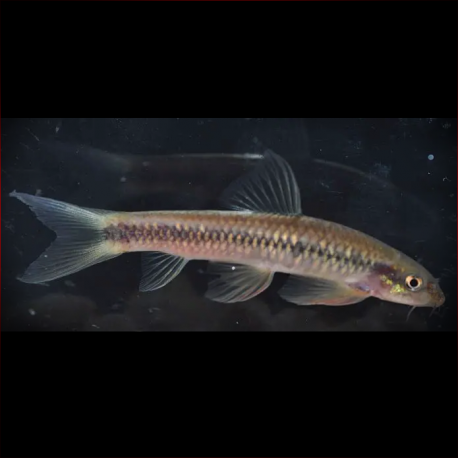More info
Datasheet
| Maximum Size | 15.5cm / 6.10inches |
General Description
The Cardamom Garra (Garra Hughi) is a species occasionally found in the ornamental trade, described by its elongate body form, broad head, and distinctive color patterns on various body parts. Belonging to the family Cyprinidae, this species is part of the enigmatic genus Garra, with ongoing taxonomic revisions and a wide distribution range across Asia and Africa.
Aquarium Setup
To recreate its natural habitat, the Cardamom Garra requires an aquarium with swiftly-flowing sections, oxygen-rich water, and ample sunlight for biofilm development. A minimum tank size of 20 gallons is recommended, with ample hiding spots created using driftwood, rocks, and live plants. Water temperature between 68-79°F (20-26°C) and a pH of 6.5-7.5 is ideal. (See table for more details).
Behaviour
Cardamom Garra species are known for their bottom-dwelling habits and use a modified lower lip to cling to surfaces in turbulent waters. They often scrape food from the substrate using their keratinised mouthparts and are adapted to specific environmental niches, such as thermal springs or hypogean habitats.
Feeding and Diet
In the aquarium, Cardamom Garras are omnivorous, with a diet consisting of algae, small invertebrates, and crustaceans. They will also feed on biofilm, making a well-established tank with natural growth essential for their nutrition. Offering sinking pellets, algae wafers, and occasional live or frozen foods will help maintain their health.
Reproduction & Dimorphism
Information on the reproductive behavior and dimorphism of the Cardamom Garra species is limited. Observations in the wild suggest that they might exhibit typical cyprinid breeding behaviors, but specific details regarding courtship, spawning, or sexual dimorphism remain to be fully documented.
Habitat and Distribution
The Cardamom Garra is native to the Anamalai, Cardamom, Palani, and Ashambu Hills of the Western Ghats mountain range in southern India. Within this region, they are found in river systems like Pambar, Periyar, Neyyar, Kallada, and Vamanapuram, as well as tributaries within the Indira Gandhi Wildlife Sanctuary. The species inhabits clear, oxygen-rich waters in headwaters and tributaries, favoring areas with abundant biofilm growth.

